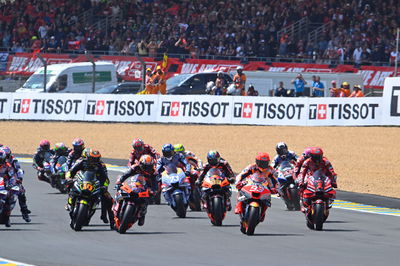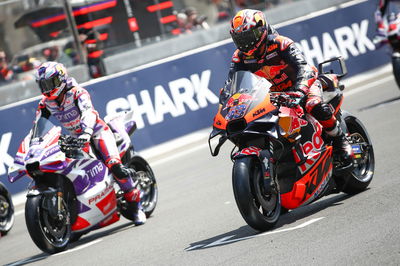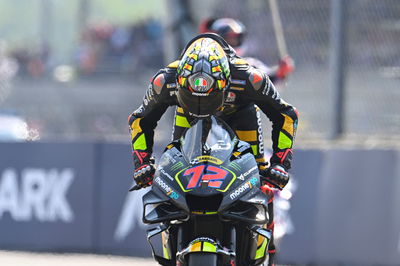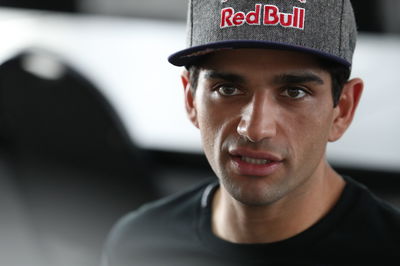'Redefining tyre performance key to future MotoGP speeds'

The only change already announced for 2027 is the move to 100% ‘non-fossil origin’ fuel, rising from 40% in 2024.
Other rumoured alternations are the removal of ride height/holeshot devices and some further limits on aerodynamics.
But with no desire for any major overhaul of the engine regulations, other ideas would be needed to have a meaningful impact on the record-breaking top speeds and lap times.
Scott Smart, World Superbike technical director from 2014-2022 and now a director of technology for Dorna and consultant for MSVR in BSB, believes one of the answers is to ‘redefine’ tyre performance.
Speaking on this week’s Crash.net MotoGP podcast, Smart explained: “Obviously MotoGP tried going to 800cc machines in the past, but the cost was quite incredible and it produced another set of problems.
“But there are a few very quick bold strokes you can do to make things slower, and generally that's to reduce massively the tyre performance.
“This is very much my opinion - not from Dorna or FIM or anybody else - but tyre performance needs to be redefined. Because right now ‘tyre performance’ means what?”
“Grip, and more of it!” answered former grand prix rider and British champion Keith Huewen.
“Exactly,” continued Smart. “But for me, tyre performance can also mean how long the tyre lasts while giving a certain amount of grip. If you could triple the life of the tyre, whilst still giving 90% of its current maximum grip, I would say that's actually improved its performance.
“We just need a bit of a mental shift because bike racing is still absolutely stuck in going faster, faster, faster. And that's what motorsport is about. But for example, in BSB, people are sometimes worried about Superstock being as fast as Superbike.
“But nobody stands at the side of the track and goes, ‘wow, that Superstock bike was only 0.3 of a second a lap slower. That's too close’. You go: ‘Wow. Did you see that?’ Because the reality is we're interested in really exciting racing.
“You don't see two seconds per lap difference when you watch on television. So we can massively reduce the mid-corner speed.
“Some of the most fantastic 500cc races from the ‘90s were when those things had 160 horsepower and no grip. The racing was phenomenal. And that's what we want. We don't necessarily need to find that last one second a lap.
“So we could redefine our performance goals and massively reduce the consumption in tyres. For example, only have a few sets per weekend, but they've got to have incredible tyre life and the net effect immediately is that there's going to be less available grip.
“The lap times will slowly come back anyway [with technical improvements by the manufacturers] but you’d get yourself 3, 5, 7 years before you need to slow it all down again.
“Also, from my point of view, managing the quantity of fuel flow, and the quality of fuel is another area that can be looked at. If we reduce certain components, it gives the engineers a challenge.
“In top-level motorbike racing, MotoGP or World Superbikes, a lot of the funding comes from the R&D side of the company.
“So they need to be able to justify why they're sending engineers around the world - not just to get suntans! - but to actually provide information that's useful, gets passed back into the company and ultimately rolled into the street bikes.
“There are a couple of ways of slowing MotoGP down. But the politics at the moment are quite difficult and making [technical] decisions quickly is getting harder than ever... And no one likes change!”
Asked about the need to strike a balance between road relevance and encouraging prototype innovation in the premier class, Smart replied:
“You can see it in a couple of ways. I think it's really interesting to develop the new tech, but then once it becomes ubiquitous, so the knowledge has gone back into the company, which is the net goal, and it doesn’t add anything to the racing then potentially you say ‘OK, we don't need it in racing anymore, move on to the next thing’.
“And there will be the next thing and the next thing... All the stuff that we don't think of that Gigi [Dall’Igna] kind of imagines at 4:00am in the morning!”

On the specific topic of ride-height devices, likely to be removed due to a lack of road relevance and the fact all manufacturers now have them, Smart said:
“On the question of whether they've got an application on the road or not? Actually, potentially there are some knock-on effects that you don't think about.
“If a manufacturer has got that knowledge of how to change the height of a bike without adversely affecting other things, it can make a big trail [Adventure] bike, for example, much more accessible to a small person when they're riding in town.
“Then you can slip the switch when you are out on the trails and the bike can return to its normal ride height. So there are actually some interesting applications of this stuff.
“But maybe it's time has been done in MotoGP because once everybody has it, and everyone is getting the same benefit from it, it can go at that point because everybody has the same thing removed.
“It's a very, very fine line to tread. But if everyone has it, if they are not giving anything to the entertainment of our sport and costing money, then it's not necessarily particularly useful to keep.”
Download Episode 90 at the following links...
New podcasts available each week.












